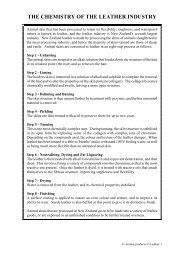BASF defoaming explanaiton
You also want an ePaper? Increase the reach of your titles
YUMPU automatically turns print PDFs into web optimized ePapers that Google loves.
Splendid surfaces<br />
for deep impressions<br />
Defoamers and slip & leveling agents<br />
Application guide – Formulation Additives
Defoaming and<br />
surface control<br />
Tiny amounts of an additive can make a world of difference<br />
to a coating’s performance.<br />
<strong>BASF</strong> offers a comprehensive range of surface modifying<br />
additives under the brand name Efka ® .<br />
Contents<br />
Defoaming<br />
What is foam? 04<br />
How do defoamers work? 04<br />
Choosing a defoamer 05<br />
Different defoamers for different systems 05<br />
Efka ® defoamers – product summary 06<br />
Wetting<br />
Surface tension 08<br />
Wetting process 08<br />
Surface control<br />
Surface defects 10<br />
Leveling 12<br />
Slip 12<br />
Chemistry behind 13<br />
Efka ® slip and leveling agents – product summary 14
02 03
Defoaming<br />
During the production and application of paint systems,<br />
foam is an undesired side-effect of mixing, usually slowing<br />
production and making it difficult to fill vessels with the<br />
correct amount of paint, in addition to causing surface<br />
defects such as craters and weak points in the dried film.<br />
What is foam?<br />
Foam can be described as a stable dispersion of gas<br />
bubbles in a liquid medium.<br />
In pure liquids, foam is not stable. Foam is only stable in<br />
systems containing surfactant-like substances such as<br />
wetting agents, or certain surface control additives needed<br />
to improve important properties of the paint; surface active<br />
materials tend to migrate to the air/liquid interface of the<br />
paint, thereby reducing the surface tension.<br />
Foam originates at various stages of production, such as<br />
pumping, stirring, dispersing, and also the application of<br />
a liquid paint, through the entrapment of air bubbles. The<br />
air-liquid interface of these bubbles is surrounded by the<br />
surface-active materials in the paint. Due to the bubbles’<br />
low density, they rise to the surface in low-viscosity paints.<br />
As the bubbles rise, smaller bubbles can combine to form<br />
larger bubbles which rise faster. At the surface, the bubbles<br />
accumulate and deform both the surface of the paint<br />
and themselves. Surfactants create a stable double layer<br />
(lamella) that prevents air bubbles from bursting. Without<br />
surfactants, drainage of the liquid would cause thinning of<br />
the lamella and its final breakdown.<br />
However, the presence of surfactants prevent lamella<br />
thinning by<br />
• counterflow of liquid due to a surface tension<br />
difference, as result of interface stretching,<br />
called the Marangoni effect<br />
• repulsion by the surfactants at the interfaces, through<br />
steric and electrostatic mechanisms. These stabilizing<br />
effects result in elasticity of the lamella, preventing<br />
them from reaching a critical thickness of ca. 10 nm,<br />
which is the criterion for lamella breakage.<br />
How do defoamers work?<br />
To eliminate foam, these stabilizing effects must be avoided<br />
using defoamer(s), which should have one or more of the<br />
following properties:<br />
• foam destruction to eliminate existing foam<br />
• foam prevention to avoid formation of foam<br />
• air release to assist an air bubble to rise to the surface<br />
What is foam?<br />
How do defoamers work?<br />
defoamer<br />
without surfactants with surfactants entering spreading bursting
Defoamers act mainly in the stabilized lamella. Therefore<br />
they must be insoluble in the paint system, mobile so that<br />
they can enter in the lamella and spread at the interface<br />
to displace the surfactants. Defoamers must have a lower<br />
surface tension than the surfactant, leading to an opposite<br />
Marangoni effect, i.e. fast thinning and collapse of the<br />
lamella.<br />
Choosing a defoamer<br />
Possible chemical entities for defoamers are molecules<br />
with a low surface tension such as silicone and mineral<br />
oils, fatty acid and fluorocarbons. To increase the<br />
<strong>defoaming</strong> efficiency, solid particles with a low surface<br />
tension can be included, such as hydrophobic silica and<br />
metallic soaps. These materials can be incorporated in<br />
carriers such as water or organic solvents to promote<br />
addition and enable faster distribution of the active<br />
substance in the liquid paint. 100 % active defoamers are<br />
suitable for systems subjected to shear stresses<br />
such as grinding, ensuring their distribution and activity<br />
as a defoamer.<br />
Different defoamers for different systems<br />
For solvent-borne and solvent-free systems<br />
polysiloxanes, polyacrylates and polyolefins are effective,<br />
because these types of systems already have a low surface<br />
tension. Pure polydimethylsiloxanes can also be used but<br />
are critical in terms of their compatibility due to side-effects<br />
such as cratering. The best balance between compatibility<br />
and incompatibility is achieved through organically-modified<br />
polysiloxanes. Modification with fluorine gives even lower<br />
surface tensions.<br />
For water-borne systems a wider range of chemical<br />
structures can be used due to the generally higher surface<br />
tension of these systems; here mineral oil types and<br />
silicones are highly effective.<br />
An important point to consider is the incorporation of<br />
the defoamer in the paint system. The defoamer is not<br />
soluble in the system, so a good distribution of the active<br />
substance is necessary. This should be controlled by the<br />
mixing speed and time, otherwise craters can be formed<br />
and/or loss of <strong>defoaming</strong> efficiency is observed.<br />
Without and<br />
with defoamer<br />
04 05
Efka ® defoamers<br />
Product summary<br />
Product name Chemical type Incorporation Dosage* [%]<br />
Solvent-borne<br />
coatings<br />
Silicone-free<br />
defoamers<br />
Efka ® 2018 N solution of <strong>defoaming</strong> substances before or after processing 0.1 - 1.0<br />
Efka ® 2020 solution of <strong>defoaming</strong> substances before or after processing 0.1 - 0.7<br />
Efka ® 2021 N solution of <strong>defoaming</strong> substances end of processing 0.1 - 2.0<br />
Efka ® 2050 solution of <strong>defoaming</strong> polymers prior to processing 0.1 - 0.5<br />
Efka ® 2526 emulsion of organic polymers and organic metal compounds before or after processing 0.1 - 1.0 -<br />
Efka ® 2720 solution of <strong>defoaming</strong> substances before or after processing 0.1 - 1.0<br />
Efka ® 2788 solution of a <strong>defoaming</strong> polymer in isopropanol at any stage of the production process 0.1 - 0.5 -<br />
Silicone<br />
containing<br />
defoamers<br />
Efka ® 2022 <strong>defoaming</strong> substances before or after processing 0.1 - 1.0<br />
Efka ® 2023 <strong>defoaming</strong> substances before or after processing 0.1 - 0.5<br />
Efka ® 2025 <strong>defoaming</strong> substances before or after processing 0.1 - 1.0<br />
Efka ® 2028 <strong>defoaming</strong> substances before or after processing 0.1 - 1.0<br />
Efka ® 2030 modified polydimethyl siloxane prior to processing 0.1 - 1.0<br />
Efka ® 2035 <strong>defoaming</strong> substances final production 0.5 - 1.0<br />
Efka ® 2038 <strong>defoaming</strong> substances final production 0.1 - 0.5<br />
Efka ® 2040 <strong>defoaming</strong> substances final production 0.1 - 0.7<br />
Efka ® 2527 emulsions of organic polymers and organic metal compounds before or after processing 0.1 - 1.0 -<br />
Efka ® 2550 modified poly-dimethyl-siloxane grinding stage/ final production 0.1 - 0.3 -<br />
Efka ® 2560 modified poly-dimethyl-siloxane at any stage of the production process 0.5 - 1.0 -<br />
Efka ® 2570 modified poly-dimethyl-siloxane at any stage of the production process 0.3 - 1.0 -<br />
Efka ® 2580 modified poly-dimethyl-siloxane at any stage of the production process 0.1 - 1.0 -<br />
Efka ® 2721 solution of <strong>defoaming</strong> polymers at any stage of the production process 0.5 - 1.0 -<br />
Efka ® 2722 <strong>defoaming</strong> substances before addition of pigments/ fillers 0.5 - 1.5<br />
Efka ® 2723 <strong>defoaming</strong> substances prior to processing 0.5 - 1.5
Water-borne<br />
coatings<br />
Solvent-free<br />
coatings<br />
Description/application<br />
- - polyurethane, acid-cure and NC wood finishes<br />
- - acid-cure and NC-curtain coating systems, unsaturated polyester and gelcoats<br />
- - polyurethane, acid-cure and stoving enamels<br />
- - thin layer gel-coat, room temperature cured unsaturated polyesters, casting resins and epoxy resin systems (e.g. floorings)<br />
- water-borne coatings, strong silicone-free defoamer for both millbase and letdown<br />
- - unsaturated polyester, epoxy and polyurethane systems<br />
- water-borne coatings and inks, good performance in surfactant containing formulations<br />
- - polyurethane curtain coatings and stoving enamels<br />
- - polyurethane, acid-cure and NC wood finishes<br />
- - physically drying systems and air-drying alkyds<br />
- - polyurethane, acid-cure systems, NC wood finishes and stoving enamels<br />
- air-drying systems based on acrylic, vinyl and chlorinated polymers<br />
- - physically drying systems and medium to long oil air-drying alkyds<br />
- - polyurethane, acid-cure and NC wood varnishes, good compatibility<br />
- - solvent-borne industrial and decorative finishes, including roller, brush and airless spray applications<br />
- water-borne industrial coatings<br />
- water-borne coatings and pigment concentrates where high shear processing or application exists<br />
- water-borne coating systems containing low surfactant levels<br />
- water-borne clear coat applications, water-borne pigment concentrates<br />
- water-based acrylic, low PVC and baking systems, water-borne pigment concentrates<br />
- UV curing and EBC systems<br />
- solvent-free epoxy- and polyurethane systems<br />
- solvent-free epoxy- and polyurethane systems, low odor, high solid 2k systems and solvent-free radiation curing systems<br />
* Dosage: % w/w on total formulation ** Typical values, not intended as specification<br />
06 07
Wetting<br />
Surface tension<br />
Wetting processes<br />
In the bulk of the material<br />
every molecule is equally<br />
surrounded by other<br />
molecules leading to<br />
equilibrium of forces.<br />
<br />
L<br />
S<br />
G<br />
90º < < 180º<br />
At the surface however,<br />
part of the surrounding<br />
is missing and therefore<br />
all forces are directed into<br />
the centre of molecules.<br />
<br />
L<br />
G<br />
0º < < 90º<br />
S<br />
It is even stronger at<br />
corners and edges due<br />
to less surrounding<br />
layers being present.<br />
G<br />
L<br />
S<br />
= 0º<br />
The wetting process is a central feature of<br />
paint production.<br />
Surface tension<br />
Wetting processes<br />
The main factor in the wetting process is the surface<br />
tension of the various components. In order to understand<br />
the origin of the surface tension of a given material, for<br />
example a liquid, we have to examine the surface of that<br />
material on a molecular basis.<br />
Several attractive forces may exist between single<br />
molecules: London, Van der Waals, dipoles, hydrogenbridges<br />
and ionic forces.<br />
The surface tension of a liquid or a solid can be measured<br />
by determining the contact angle. The most practical way<br />
to calculate it is by the Patton’s equation which takes into<br />
account the approximation of the solid’s surface tension<br />
(critical surface tension).<br />
This is only possible when the surface tension of the liquid<br />
is lower than the surface tension of the solid.
Successful wetting can be directly<br />
related to the size of the contact angle.<br />
• At a contact angle > 90º no wetting<br />
takes place and the droplet keeps its<br />
spherical shape.<br />
• At a contact angle < 90º wetting<br />
improves and the contact surface<br />
(droplet-solids interface) increases.<br />
• At a contact angle = 0º the desired<br />
spreading is achieved.<br />
That means in the coating industry, that only the liquid can<br />
be influenced, as the solids such as pigments and fillers,<br />
and also the substrate, have a fixed surface tension.<br />
One example of reducing the surface tension of a liquid is<br />
the addition of a surfactant. Accumulation at the surface<br />
leads to compensation of tension by interaction of the polar<br />
groups. The value obtained for the surface tension is<br />
determined by the lower surface tension of the surfactant.<br />
This concept is the basis for solving many problems<br />
associated with coatings, such as pigment wetting, and<br />
surface defects such as craters, poor flow and foam.<br />
08 09
Surface control<br />
Possible surface defects during paint application<br />
Orange peel<br />
Orange peel<br />
Pinholes<br />
Craters<br />
Fish eyes<br />
Edge crawling<br />
Craters and pinholes<br />
Air-draft sensitivity<br />
Telegraphing<br />
Floating (Bénard cells)<br />
Silking<br />
craters<br />
no craters<br />
Surface control additives are used to prevent surface<br />
defects during paint application and improve resistance<br />
and appearance of the dry film.<br />
Surface defects<br />
Orange peel – This typical appearance of the surface is<br />
only observed following spray applications. Three main<br />
factors influence this defect:<br />
• viscosity of the sprayed liquid<br />
• spraying conditions such as pressure, air/liquid ratio<br />
• surface tension of the liquid<br />
The first two factors depend strongly on the operator.<br />
The third factor can be controlled by the paint formulator.<br />
Lowering the surface tension of the liquid leads to smaller<br />
droplets under the same spray conditions and improves the<br />
flow of the single droplets after application.<br />
Craters and pinholes – Craters and pinholes are caused<br />
by liquid or solid contamination present on the substrate or<br />
in the paint, or from the surroundings, before the drying<br />
process starts. The reason for the formation of craters is<br />
the difference in surface tension between the liquid paint<br />
and the contaminant. Such defects increase, as surface<br />
tension differences grow. By lowering the surface tension of<br />
the liquid, such defects can be avoided.<br />
Pinholes are craters, where the liquid has not formed a<br />
homogeneous layer, thereby leaving a depression which<br />
penetrates to the substrate.<br />
Fish eyes – Fish eyes are caused by insufficient substrate<br />
wetting. This occurs when the surface tension of the liquid<br />
paint is higher than that of the substrate and no spreading<br />
takes place on its surface. Spreading is improved by<br />
lowering the surface tension of the liquid.
Edge crawling<br />
faster<br />
evaporation<br />
substrate<br />
substrate<br />
Floating (Bénard cells) and silking<br />
horizontal Bénard cells<br />
no Bénard cells<br />
Telegraphing – Telegraphing (ghosting) occurs, when areas<br />
of different surface tension on the substrate are formed by<br />
wiping, by residual traces of a cleaning liquid or by finger<br />
prints. These marks appear on the surface of the applied<br />
paint film. This effect is clearly seen when the substrate/<br />
base coat contains interfacial active substances.<br />
takes place, leading to a stronger increase of surface<br />
tension than in the rest of the liquid film. A higher surface<br />
tension causes the liquid to crawl, because it is trying to<br />
adopt a smaller overall surface.<br />
This problem is avoided by lowering the surface tension<br />
of the liquid.<br />
Air-draft sensitivity – Local differences in surface tension<br />
of the paint caused by non-uniform evaporation of the<br />
solvent can cause air-draft sensitivity. Locally confined<br />
evaporation leads to an increased surface tension in the<br />
film. Rupture of the film can take place when this surface<br />
tension rises above the substrate’s surface tension,<br />
and de-wetting takes place. This problem is avoided by<br />
lowering the surface tension of the liquid.<br />
Edge crawling – Edge crawling is found at the edges of<br />
the substrate, because the surface of the applied paint film<br />
is larger at the edges. Here faster evaporation of solvents<br />
Floating (Bénard cells) and silking – Floating and silking<br />
are related to processes taking place in the liquid paint<br />
during the drying phase. Differences in the density and<br />
surface tension give rise to turbulent flow of material<br />
from the lower to the upper part of the film. In pigmented<br />
systems, the pigments settle in different areas depending<br />
on their mobility. On horizontal surfaces, this floating is seen<br />
as hexagonal patterns; so-called Bénard cells. Silking has<br />
the same origin but is limited to vertical surfaces and shows<br />
as line-shaped patterns. These defects can be avoided by<br />
minimizing the surface tension differences occurring during<br />
the drying process.<br />
10 11
Surface control<br />
Slip – orientation of PDMS at coating surface<br />
CH 3<br />
CH 3<br />
CH 3<br />
CH 3<br />
CH 3<br />
CH 3<br />
CH 3<br />
CH 3<br />
O<br />
Si<br />
Si Si Si<br />
O O O O<br />
Leveling<br />
Slip<br />
All these defects are caused by differences and changes<br />
in the surface tensions of the liquid paint, substrate and<br />
contaminants.<br />
With “Wetting” it was shown that effective wetting of a solid<br />
takes place when the liquid has a lower surface tension<br />
than the solid. When the surface tension of the liquid paint<br />
is high, the system is more sensitive to wetting defects.<br />
In general, modern synthetic resins have a higher surface<br />
tension than those based on natural fatty acids. Aqueous<br />
systems have a high surface tension due to their polarity.<br />
The main solution to these problems is to adjust the<br />
surface tension of the liquid to that of the solid. Therefore<br />
additives to improve leveling need a low intrinsic surface<br />
tension and a high mobility towards the interface they have<br />
to influence.<br />
An additional requirement for a coating is good slip. This socalled<br />
“slip” improves the aesthetic impression and helps to<br />
protect the film against scratches, metal marking and dirt. Slip<br />
properties are only achieved by using long chain polysiloxanes<br />
containing dimethylsiloxane groups. The friction at the surface<br />
caused by irregularities is reduced by the lubrication effect<br />
of the dimethylsiloxane groups concentrated at the surface,<br />
without producing a greasy layer.<br />
The slip can easily be determined by slip angle measurement<br />
or by touch.<br />
Protection by slip is most important in the initial drying stage,<br />
where the surface is still vulnerable to mechanical influences.<br />
Only a small amount of silicone-leveling agent is needed for<br />
the optimum slip performance, whereas over-dosage can lead<br />
to unwanted side-effects.<br />
A common unwanted side-effect of some polyether-modified<br />
siloxanes is their surface-activity, sometimes giving rise to<br />
foam stabilization. Often, therefore, the simultaneous use of a<br />
defoamer is recommended.<br />
Alternatively, an alkyl-modified siloxane or polyacrylate can be<br />
used as leveling agent to avoid foam formation during paint<br />
application.
Chemistry behind<br />
The Efka ® range of slip and leveling agents are based on<br />
the following chemical families:<br />
• Long chain polysiloxanes are the most common leveling<br />
agents in the coating industry. Pure polydimethyl<br />
siloxanes are not used in the Efka ® range due to their<br />
incompatibility with many resins. To improve this, the<br />
polydimethyl siloxane backbone is modified with alkyl or<br />
polyether side chains. In addition, reactive groups such<br />
as isocyanates, double bonds, hydroxyl groups and acid<br />
groups can be incorporated, leading to the advantage<br />
that the leveling agent can be crosslinked into the film.<br />
They are suitable for solvent-borne systems, water-borne<br />
systems or both, depending on the type of side-chain<br />
used.<br />
• Polyacrylates are produced from special monomers<br />
with a low surface tension. These structures move to<br />
the interface, equalizing the surface tensions. They are<br />
known for not causing inter-coat adhesion problems in<br />
the dry film, and depending on their modification, they<br />
can be used in solvent- or water-borne systems.<br />
• Short chain polysiloxanes were developed to bring<br />
silicone-based leveling agents which will not affect<br />
intercoat adhesion. The main benefit is found in waterbased<br />
systems.<br />
12 13
Efka ® slip and<br />
leveling agents<br />
Product name Chemical type Incorporation Dosage* [%]<br />
Active<br />
content** [%]<br />
Slip and<br />
leveling agents<br />
based on<br />
polysiloxane<br />
Efka ® 3030 organically modified polysiloxane any stage 0.1 - 0.3 52<br />
Efka ® 3031 organically modified polysiloxane any stage 0.1 - 0.3 52<br />
Efka ® 3033 organically modified polysiloxane any stage 0.1 - 1.0 15<br />
Efka ® 3034 fluorocarbon modified polysiloxane any stage 0.1 - 0.2 52<br />
Efka ® 3035 organically modified polysiloxane any stage 0.1 - 0.5 52<br />
Efka ® 3236 solvent-free modified polysiloxane after thinning 0.04 - 0.4 100<br />
Efka ® 3239 solvent-free modified polysiloxane after thinning 0.05 - 0.5 100<br />
Efka ® 3288 organically modified polysiloxane any stage 0.02 - 0.3 100<br />
Efka ® 3299 organically modified polysiloxane any stage 0.05 - 0.3 100<br />
Efka ® 3580 polysiloxane after or prior to processing 0.1 - 1.0 100<br />
Reactive slip<br />
and leveling<br />
agents based<br />
on polysiloxane<br />
Efka ® 3883 polysiloxane modified with unsaturated terminal groups end of process 0.2 - 1.0 70<br />
Efka ® 3886 polysiloxane modified polyisocyanates added to the hardener 2 - 3*** 50<br />
Efka ® 3888 polysiloxane modified polyisocyanates added to the hardener 1 - 2*** 45<br />
Leveling agents<br />
based on<br />
polyacrylates,<br />
solvents or<br />
silicone-free<br />
surfactants<br />
Efka ® 3037 solvent blend of high boiling aromatics, ketones and esters before or after processing 3 - 7 -<br />
Efka ® 3038 solvent blend of high boiling aromatics, ketones and esters before or after processing 5 - 7 -<br />
Efka ® 3277 fluorocarbon modified polyacrylate before or after processing 0.5 - 2.0 100<br />
Efka ® 3360 sodium dioctyl sulfosuccinate in water and isopropanol before or after processing 0.5 - 3.0 60<br />
Efka ® 3370 sodium dioctyl sulfosuccinate in water and propylene glycol before or after processing 0.5 - 3.0 70<br />
Efka ® 3570 fluorocarbon modified polyacrylate before or after processing 0.5 - 1.5 60<br />
Efka ® 3600 polymeric fluorocarbon compound before or after processing 0.1 - 0.5 100<br />
Efka ® 3650 polymeric fluorocarbon compound before or after processing 0.1 - 1.0 50<br />
Efka ® 3772 fluorocarbon modified polyacrylate end of process 0.5 - 2.0 60<br />
Efka ® 3777 fluorocarbon modified polyacrylate end of process 0.5 - 1.0 70<br />
Efka ® 3778 acrylic polymer end of process 0.5 - 2.0 70<br />
Efka ® 3785 acrylic copolymer end of process 0.5 - 1.5 50<br />
Irgaflow ® 100 fluor modified polyacrylate before, after or during processing 0.5 - 1.0 50<br />
Irgaflow ® 110 fluor modified polyacrylate before, after or during processing 0.1 - 0.5 70
Solvent-borne<br />
coatings<br />
Water-borne<br />
coatings<br />
Solvent-free<br />
coatings<br />
Description/application<br />
- improved slip & mar resistance, very compatible<br />
- - solvent-borne metal-, wood- and paper coatings, including UV cured<br />
- - improved surface flow, excellent compatibility in clear coat<br />
- strong substrate wetting and anti-cratering<br />
- solvent- and water-borne coatings, stoving enamels, unsaturated PE including UV cured<br />
- solvent-borne wood finishes, industrial coatings and solvent-free floor coatings<br />
- similar to Efka ® 3236 but stronger <strong>defoaming</strong> properties<br />
strong slip and surface smoothness effect for high gloss industrial coatings<br />
strong slip and surface smoothness effect for high gloss industrial coatings<br />
- - anti-cratering and leveling agent for water-borne coatings<br />
- - UV curing systems for wood- and plastic and paper coatings<br />
- - polyurethane wood coatings including moisture cured<br />
- - polyurethane metal coatings<br />
- - flow agent, prevent surface defects, cob-webbing, streaking, chilling, shorten setting time<br />
- - Air drying and stoving enamels<br />
- solvent-free version of Efka ® 3777<br />
- - water-borne coating and inks, good substrate wetting and dynamic behaviour<br />
- - same as Efka ® 3360 with different solvent blend<br />
- - excellent substrate wetting, leveling and anti-cratering<br />
-<br />
stoving enamels based on polyesters or acrylics, 2 pack polyurethane, 2 pack epoxy and air dried alkyd<br />
systems, strong anti cratering, leveling and substrate wetting<br />
- - diluted version of Efka ® 3600<br />
- leveling and anti cratering<br />
- solvent-borne systems, coil coatings, OEM and industrial coatings<br />
- - coil coatings, solvent-borne and solvent-free systems<br />
- - leveling agent for industrial coatings, coil coatings, 2k PUR, 2k Epoxy, stoving enamels<br />
* Dosage: % w/w on total formulation<br />
** Typical values, not intended as specification<br />
*** % on polyol component<br />
-<br />
-<br />
solvent-based industrial- and wood coatings, improved leveling and <strong>defoaming</strong> performance compared<br />
to Efka ® 3777<br />
solvent-based industrial- and wood coatings, higher leveling and anti crater efficiency then<br />
Irgaflow ® 100, improved leveling and <strong>defoaming</strong> performance compared to Efka ® 3600<br />
14 15
Contact and technical support worldwide<br />
Asia<br />
<strong>BASF</strong> East Asia Regional Headquarters Ltd.<br />
45/F, Jardine House<br />
Ni. 1 Connaught Place<br />
Central<br />
Hong Kong<br />
formulation-additives-asia@basf.com<br />
Europe<br />
<strong>BASF</strong> SE<br />
Additives<br />
E-EDC/AF – J 550<br />
67056 Ludwigshafen<br />
Germany<br />
formulation-additives-europe@basf.com<br />
North America<br />
<strong>BASF</strong> Corporation<br />
11501 Steel Creek Road<br />
Charlotte, NJ 28273<br />
USA<br />
formulation-additives-nafta@basf.com<br />
South America<br />
<strong>BASF</strong> S.A.<br />
Av. Faria Lima 3600 – 10° andar<br />
Itaim Bibi – São Paulo – SP<br />
04538-132<br />
Brazil<br />
formulation-additives-south-america@basf.com<br />
The data contained in this publication are based on our current knowledge and<br />
experience. In view of the many factors that may affect processing and application<br />
of our product, these data do not relieve processors from carrying out their own<br />
investigations and tests; neither do these data imply any guarantee of certain<br />
properties, nor the suitability of the product for a specific purpose. Any descriptions,<br />
drawings, photographs, data, proportions, weights, etc. given herein may change<br />
without prior information and do not constitute the agreed contractual quality of the<br />
product. The agreed contractual quality of the product results exclusively from the<br />
statements made in the product specification. It is the responsibility of the recipient of<br />
our product to ensure that any proprietary rights and existing laws and legislation are<br />
observed. When handling these products, advice and information given in the safety<br />
data sheet must be complied with. Further, protective and workplace hygiene measures<br />
adequate for handling chemicals must be observed.<br />
® = registered trademark of the <strong>BASF</strong> Group<br />
<strong>BASF</strong> SE<br />
67056 Ludwigshafen<br />
Germany<br />
EDC 0511 e


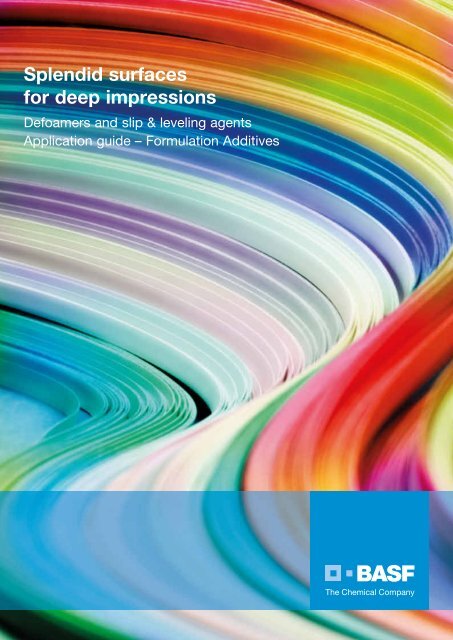



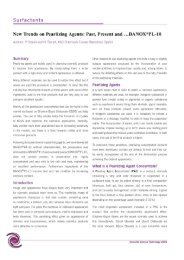

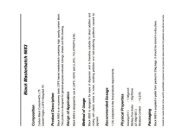


![[Ulwick_A.W.]_Business_Strategy_Formulation_Theor(BookZZ.org)](https://img.yumpu.com/56355932/1/190x240/ulwick-aw-business-strategy-formulation-theorbookzzorg.jpg?quality=85)

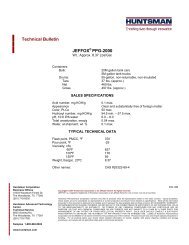

![Desmond Morris - 2002 - Peoplewatching - The Desmond Morris Guide to Body Language (poor quality-double page)(290p) [Inua]](https://img.yumpu.com/54998318/1/189x260/desmond-morris-2002-peoplewatching-the-desmond-morris-guide-to-body-language-poor-quality-double-page290p-inua.jpg?quality=85)
